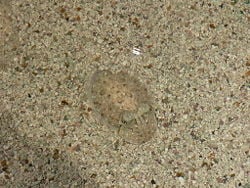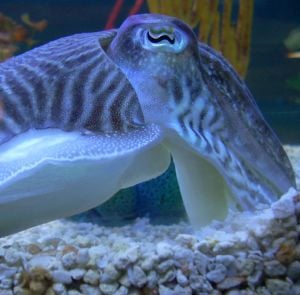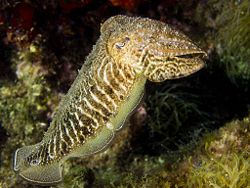Cuttlefish
| Cuttlefish | ||||||||||||
|---|---|---|---|---|---|---|---|---|---|---|---|---|
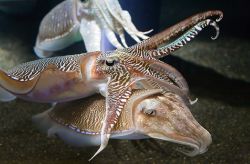 Two cuttlefish interact while a third looks on. Georgia Aquarium
| ||||||||||||
| Scientific classification | ||||||||||||
| ||||||||||||
|
Cuttlefish are marine animals of the order Sepiida belonging to the Cephalopoda class (which also includes squid, octopuses, and nautiluses). Despite their common name, cuttlefish are not fish but molluscs. Recent studies indicate that cuttlefish are among the most intelligent invertebrate species.[1]
squid-like, ten tentacles and arms, cuttlebone mollusk of the cmprinsing order ** of (member of order *** in some classifications).
Cuttlefish have an internal shell (cuttlebone), large W-shaped pupils, and eight arms and two tentacles furnished with denticulated suckers, with which they secure their prey.
(Tentacles tend to be longer than arms and usually have suckers as their tips only.
A cuttlefish can not only rapidly change its colors, color patterns, and color intensity to blend with its background, but this cephalopod can even change skin texture to match its habitat, better concealing itself as its moves among the various sandy areas, corals, and rocks of its marine environment.
Cuttlefish eat small molluscs, crabs, shrimp, fish and other cuttlefish. Their predators include dolphins, sharks, fish, seals and other cuttlefish. Their life expectancy is about one to two years.
Overview and description
Cuttlefish are members of the Mollusca phylum, a taxon that includes such familiar animals as snails, clams, oysters, mussels, nudibranchs, abalones, and octopuses. Together with squid, octopus, and nautilus, cuttlefish belong to the mollusk class Cephalopoda, whose members, all marine in habitat, are characterized by bilateral body symmetry, a prominent head, and a modification of the mollusk foot into the form of arms or tentacles surrounding the mouth. Cephalopods have the most complex nervous system among invertebrates, and large and image-focusing, vertebrate-like eyes. The highly developed neural organs allows them to have an excellent capacity to learn and remember; nonetheless, most are short-lived, in the order of months or a few years.
The class Cephalopoda contains two extant (living) subclasses. Cuttlefish belong to the subclass Coleoidea, along with octopuses, squids, and the extinct belemites. Members of Coleoidea are characterized by the mollusk shell being internalized or absent, as opposed to members of the subclass Nautiloidea, whose members are characterized by an external shell.
Among the extant Coleoidea, cuttlefish are distinguished from the octopuses by the cuttlefish having eight arms and two tentacles, while octopuses have eight arms and no tentacles. (Tentacles tend to be longer than arms and usually have suckers as their tips only.) Squids also, at some point in their life cycle, have eight arms and two tentacles. Cuttlefish differ from squid in that cuttlefish have an internal shell (cuttlebone) on their back.
- 8 Cuttlefish are placed together in the order ***
Previously, *** was order, comprising several gropus But ****
Cuttlebone
Cuttlefish possess an internal structure called the cuttlebone, which is porous and composed of calcium carbonate, to provide the cuttlefish with buoyancy. Buoyancy can be regulated by changing the gas-to-liquid ratio in the chambered cuttlebone. Each species has a distinct shape, size, and pattern of ridges or texture on the cuttlebone. The cuttlebone is unique to cuttlefish, one of the features contrasting them with their squid relatives. Cuttlebones are traditionally used by jewelers and silversmiths as moulds for casting small objects.[2] They are probably better known today as the tough material given to parakeets and other caged birds and snails as a source of dietary calcium.
Changing color and texture of skin
Cuttlefish are sometimes called the chameleon of the sea because of their remarkable ability to rapidly alter their skin color at will. Their skin flashes a fast-changing pattern as communication to other cuttlefish and to camouflage them from predators. This color-changing function is produced by groups of red, yellow, brown, and black pigmented chromatophores above a layer of reflective iridophores and leucophores, with up to 200 of these specialized pigment cells per square millimeter. The pigmented chromatophores have a sac of pigment and a large membrane that is folded when retracted. There are 6-20 small muscle cells on the sides which can contract to squash the elastic sac into a disc against the skin. Yellow chromatophores (xanthophores) are closest to the surface of the skin, red and orange are below (erythrophores), and brown or black are just above the iridophore layer (melanophores). The iridophores reflect blue and green light. Iridophores are plates of chitin or protein, which can reflect the environment around a cuttlefish. They are responsible for the metallic blues, greens, golds, and silvers often seen on cuttlefish. All of these cells can be used in combinations. For example, orange is produced by red and yellow chromatophores, while purple can be created by a red chromatophore and an iridophore. The cuttlefish can also use an iridophore and a yellow chromatophore to produce a brighter green. As well as being able to influence the color of the light that reflects off their skin, cuttlefish can also affect the light's polarization, which can be used to signal to other marine animals, many of which can also sense polarization.
With the exception of Nautilus, cephalopods have special skin cells called chromatophores that change color and are used for communication and camouflage. Cuttlefish are known as "chameleons of the sea" for their ability to change skin color and patterns. (See camouflage.) A cuttlefish can not only rapidly change its colors, color patterns, and color intensity to blend with its background, but this cephalopod can even change skin texture to match its habitat, better concealing itself as its moves among the various sandy areas, corals, and rocks of its marine environment. Cuttlefish are known as "chameleons of the sea" for their ability to change skin color and patterns, although the cuttlefish color changes are actually much faster and more intricate than that of the chameleon, changing as they swim over different surfaces.
Octopuses and cuttlefish are also noted for the ability to change the texture of their skin to match their environment, such as having bumpy projections when over a coral reef or smooth skin when over sand.
Eyes
Cuttlefish eyes are among the most developed in the animal kingdom. The organogenesis of cephalopod eyes differs fundamentally from that of vertebrates like humans.[3] Superficial similarities between cephalopod and vertebrate eyes are thought to be examples of convergent evolution. The cuttlefish pupil is a smoothly-curving W shape. Although they cannot see color,[4] they can perceive the polarization of light, which enhances their perception of contrast. They have two spots of concentrated sensor cells on their retina (known as fovea), one to look more forward, and one to look more backwards. The lenses, instead of being reshaped as they are in humans, are pulled around by reshaping the entire eye in order to change focus.
Scientists have speculated that cuttlefish's eyes are fully developed before birth and start observing their surroundings while still in the egg. One team of French researchers has additionally suggested that cuttlefish prefer to hunt the prey they saw before hatching.[5]
Blood
The blood of a cuttlefish is an unusual shade of green-blue because it uses the copper-containing protein hemocyanin to carry oxygen instead of the red iron-containing protein hemoglobin that is found in mammals. The blood is pumped by three separate hearts, two of which are used for pumping blood to the cuttlefish's pair of gills (one heart for each gill), and the third for pumping blood around the rest of the body. A cuttlefish's heart must pump a higher blood flow than most other animals because hemocyanin is substantially less capable of carrying oxygen than hemoglobin.
Toxicity
Recently it has been discovered that the Pfeffer's Flamboyant Cuttlefish's muscles contain a highly toxic compound that is yet to be identified. [1] Research by Mark Norman with the Museum Victoria in Queensland, Australia, has shown the toxin to be as lethal as that of a fellow cephalopod, the Blue-ringed octopus.[6]
Ink
Cuttlefish have ink, like squid and octopuses. This ink was formerly an important dye, called sepia. Today artificial dyes have replaced natural sepia. However, there is a modern resurgence of Jewish people using the ink for the techelet dye on their Tallit strings.[citation needed]
Classification
There are over 120 species of cuttlefish currently recognised, grouped into 5 genera. Sepiadariidae contains seven species and 2 genera; all the rest are in Sepiidae.
- CLASS CEPHALOPODA
- Subclass Nautiloidea: nautilus
- Subclass Coleoidea: squid, octopus, cuttlefish
- Superorder Octopodiformes
- Superorder Decapodiformes
- ?Order †Boletzkyida
- Order Spirulida: Ram's Horn Squid
- Order Sepiida: cuttlefish
- Suborder †Vasseuriina
- Family †Vasseuriidae
- Family †Belosepiellidae
- Suborder Sepiina
- Family †Belosaepiidae
- Family Sepiadariidae
- Family Sepiidae
- Suborder †Vasseuriina
- Order Sepiolida: bobtail squid
- Order Teuthida: squid
As food
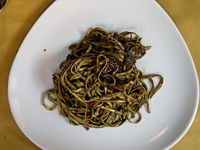
| commercial |
|---|
| mollusks |
| abalone |
| clams |
| cockles |
| periwinkles |
| mussels |
| oysters |
| scallops |
|
|
| cephalopods |
|
|
| fisheries |
|
|
| I N D E X |
Cuttlefish are caught for food in the Mediterranean, East Asia, the English Channel and elsewhere. Although squid is more popular as a restaurant dish all over the world, in East Asia dried shredded cuttlefish is a highly popular snack food.
Cuttlefish is especially popular in Italy, where it is used in Risotto al Nero di Seppia (literally black cuttlefish rice). The Croatian Crni Rižot is virtually the same recipe, which probably originated in Venice and then spread across both coasts of the Adriatic. "Nero" and "Crni" mean black, the color the rice turns because of the cuttlefish ink. Spanish cuisine, especially that of the coastal regions, uses cuttlefish and squid ink for the marine flavor and smoothness it provides; it is included in dishes such as rice, pasta and fish stews.
In literature
Eugenio Montale's ground-breaking debut collection of poetry Cuttlefish Bones (Ossi di seppia) was published in Turin in 1925. Montale, who grew up in Liguria along the Mediterranean Sea, was awarded the Nobel Prize for Literature in 1975, for his long and prolific career. Cuttlefish Bones remains one of the best-known and influential collections of 20th-century poetry.
In the popular novel Twenty Thousand Leagues Under the Sea by Jules Verne, Captain Nemo and his companions engage in a fierce battle with a group of giant cuttlefish. Although the creatures are defeated, one of the crew members is killed during the fight. Although Jules Verne accurately describes the cuttlefish's three hearts, he describes their blood as being red, instead of its actual greenish tint.
A 1923 drama by Stanisław Ignacy Witkiewicz is titled The Cuttlefish.
In his story The Call of Cthulhu, author H.P. Lovecraft likens the evil alien god's head to that of a cuttlefish.
In Rudy Rucker's 2007 novel Postsingular cuttlefish have mythical significance to people in a parallel universe (where they have already been fished to extinction). These "hibrane people" travel to our world to catch them, or steal them from fisherman's catches, causing them to mysteriously disappear.
In South Sea Adventure, by Willard Price, the protagonists are warned of a "fifty-foot cuttlefish". As no such cuttlefish exists, it is probable the creature described was a squid.
In the Poetry Collection 'Dragons' by Matthew Francis, there is a poem titled 'What the Cuttlefish Do', which makes various references to Cuttlefish, including their ability to change colour and mating habits.
ReferencesISBN links support NWE through referral fees
- ↑ 1.0 1.1 NOVA, 2007. Cuttlefish: Kings of Camouflage. (television program) NOVA, PBS, April 3, 2007.
- ↑ Casting Silver with Cuttlefish
- ↑ Muller, Matthew. "Development of the Eye in Vertebrates and Cephalopods and Its Implications for Retinal Structure". The Cephalopod Eye. Davidson College Biology Department. Retrieved 2007-04-06.
- ↑ Mäthger, Lydia M.. "Color blindness and contrast perception in cuttlefish (Sepia offcinalis) determined by a visual sensorimotor assay". Vision Research, Volume 46, Issue 11, May 2006. Elsevier Ltd.. Retrieved 2007-09-03.
- ↑ BBC News. Cuttlefish spot target prey early. Retrieved 2008-05-06.
- ↑ Teacher's Guide to NOVA episode - Kings of Camouflage on PBS (After Watching: Activity 2).
- O'Shea, S. 2006. Giant Squid and Colossal Squid Fact Sheet. Tonmo (The Octopus News Magazine Online). Retrieved January 21, 2007.
http://www.itis.gov/servlet/SingleRpt/SingleRpt?search_topic=TSN&search_value=82331
Sepiida Zittel, 1895
Taxonomic Serial No.: 82331
1999
External links
- Scientific Database with photos and videos of cuttlefish and other cephalopods
- TONMO.com offers articles and forum discussion on cuttlefish care
- YouTube video of a cuttlefish harassing a diver
- Youtube video of a tiny cuttlefish.
- YouTube video of cuttlefish hovering about. You can see colour changes and movement.
- YouTube video with excellent examples of color and texture modulation.
- Youtube video Cuttlefish changing colour and shape
- Amazing cuttlefish - Cephalopods with natural camouflage and sepia ink
- Diving with cuttlefish
- PBS.org - Nova - Kings of Camouflage
Credits
New World Encyclopedia writers and editors rewrote and completed the Wikipedia article in accordance with New World Encyclopedia standards. This article abides by terms of the Creative Commons CC-by-sa 3.0 License (CC-by-sa), which may be used and disseminated with proper attribution. Credit is due under the terms of this license that can reference both the New World Encyclopedia contributors and the selfless volunteer contributors of the Wikimedia Foundation. To cite this article click here for a list of acceptable citing formats.The history of earlier contributions by wikipedians is accessible to researchers here:
The history of this article since it was imported to New World Encyclopedia:
Note: Some restrictions may apply to use of individual images which are separately licensed.
